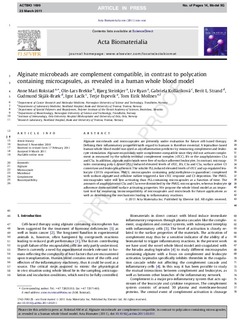| dc.contributor.author | Rokstad, Anne Mari | |
| dc.contributor.author | Brekke, Ole Lars | |
| dc.contributor.author | Steinkjer, Bjørg | |
| dc.contributor.author | Ryan, Liv | |
| dc.contributor.author | Kolláriková, Gabriela | |
| dc.contributor.author | Strand, Berit Løkensgard | |
| dc.contributor.author | Skjåk-Bræk, Gudmund | |
| dc.contributor.author | Lacík, Igor | |
| dc.contributor.author | Espevik, Terje | |
| dc.contributor.author | Mollnes, Tom Eirik | |
| dc.date.accessioned | 2017-10-26T13:30:07Z | |
| dc.date.available | 2017-10-26T13:30:07Z | |
| dc.date.created | 2011-04-06T14:53:22Z | |
| dc.date.issued | 2011 | |
| dc.identifier.citation | Acta Biomaterialia. 2011, 7 (6), 2566-2578. | nb_NO |
| dc.identifier.issn | 1742-7061 | |
| dc.identifier.uri | http://hdl.handle.net/11250/2462411 | |
| dc.description.abstract | Alginate microbeads and microcapsules are presently under evaluation for future cell-based therapy. Defining their inflammatory properties with regard to humans is therefore essential. A lepirudine-based human whole blood model was used as an inflammation predictor by measuring complement and leukocyte stimulation. Alginate microbeads were complement-compatible since they did not activate complement as measured by the soluble terminal complement complex (sTCC), Bb or the anaphylatoxins C3a and C5a. In addition, alginate microbeads were free of surface adherent leukocytes. In contrast, microcapsules containing poly-L-lysine (PLL) induced elevated levels of sTCC, Bb, C3a and C5a, surface active C3 convertase and leukocyte adhesion. The soluble PLL induced elevated levels of sTCC and up-regulated leukocyte CD11b expression. PMCG microcapsules containing poly(methylene-co-guanidine) complexed with sodium alginate and cellulose sulfate triggered a fast sTCC response and C3 deposition. The PMCG microcapsules were still less activating than PLL-containing microcapsules as a function of time. The amounts of anaphylatoxins C3a and C5a were diminished by the PMCG microcapsules, whereas leukocyte adherence demonstrated surface activating properties. We propose the whole blood model as an important tool for measuring bioincompatibility of microcapsules and microbeads for future applications as well as determining the mechanisms leading to inflammatory reactions. | nb_NO |
| dc.language.iso | eng | nb_NO |
| dc.publisher | Elsevier | nb_NO |
| dc.rights | Attribution-NonCommercial-NoDerivatives 4.0 Internasjonal | * |
| dc.rights.uri | http://creativecommons.org/licenses/by-nc-nd/4.0/deed.no | * |
| dc.title | Alginate microbeads are complement compatible, in contrast to polycation containing microcapsules, as revealed in a human whole blood model | nb_NO |
| dc.type | Journal article | nb_NO |
| dc.type | Peer reviewed | nb_NO |
| dc.description.version | acceptedVersion | nb_NO |
| dc.source.pagenumber | 2566-2578 | nb_NO |
| dc.source.volume | 7 | nb_NO |
| dc.source.journal | Acta Biomaterialia | nb_NO |
| dc.source.issue | 6 | nb_NO |
| dc.identifier.doi | 10.1016/j.actbio.2011.03.011 | |
| dc.identifier.cristin | 801295 | |
| dc.description.localcode | © 2011. This is the authors’ accepted and refereed manuscript to the article. This manuscript version is made available under the CC-BY-NC-ND 4.0 license http://creativecommons.org/licenses/by-nc-nd/4.0/ | nb_NO |
| cristin.unitcode | 194,65,15,0 | |
| cristin.unitcode | 194,66,15,0 | |
| cristin.unitname | Institutt for kreftforskning og molekylær medisin | |
| cristin.unitname | Institutt for bioteknologi | |
| cristin.ispublished | true | |
| cristin.fulltext | original | |
| cristin.qualitycode | 1 | |

